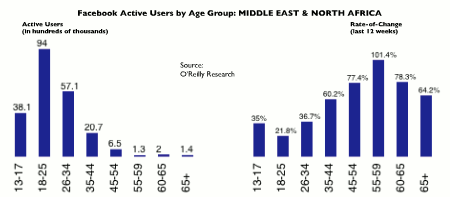Over the past few days, a number of articles sprung up about reports and predictions that have been announced by various parties, analyzing where the Internet stands today in the Arab world, and where they see it a few years from now.
Here is a quick straight-forward round-up of these opinions, reports and projections:
Present day:
- At present there are roughly around 56 million Arab internet users in the Arab world, representing only 17% of the 337 million population. [Madar Research]
- There is not enough Arabic content on the internet to take full advantage of newly built broadband networks in the region. [Ali al Ahmed, chief strategist, Etisalat]
- More people are getting online in the Arab world, and are relying more and more on the Internet for their news, videos, social interactions and more, but only 1% of all content online is in Arabic, not offering them much choice. [Arab Media Outlook report]
- Online news consumption is gaining ground with 22% to 34% of the people using internet at least as much as print media to read news. [Arab Media Outlook report]
- On average, 70% of the people in the four main Arab markets researched use social networks in some capacity and about 15% use social networking sites at least once a day. [Arab Media Outlook report]
- About 6 million internet users in the Middle East – or about 12% of the total online population in the region – have access to broadband networks. [Arab Media Outlook report]
- People in the Arab world are spending about three hours per day on the internet on average, which is already on par with the amount of time spent on TV. [Arab Media Outlook report]
- About $56 million or 1% of the total media advertising spend is online in the Middle East. [Arab Media Outlook report]
- The number of Arabic internet users in the Middle East and North Africa is expected to grow by nearly 50% over the next three years, rising to 82 million users by 2013. [Vint Cerf, Chief Internet Evangelist, Google]
- Broadband usage in the region is expected to grow at an annual rate of 25% until 2013. [Arab Media Outlook report]
- Broadband growth around the region over the next five years will stimulate the media industry, driven largely by Egypt and Saudi Arabia. [Arab Media Outlook report]
- Internet advertising spend in the Middle East will rise to at least 4.5% by 2013, to around $266 million. [Arab Media Outlook report]
[Sources: The National, Zawya, BI-ME, Arabian Business, AMEInfo]
 A new study entitled
A new study entitled 



